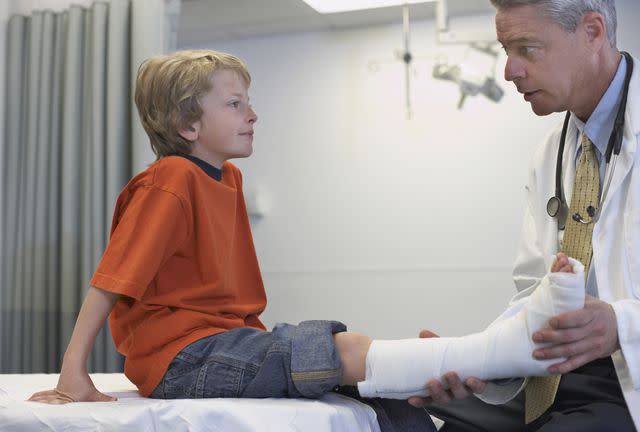Overview of Salter-Harris Fractures in Children
Why a break in the growth plate is so concerning
Medically reviewed by Lyndsey Garbi, MD
A Salter-Harris fracture is a break near, through, or along the growth plate in a bone. This usually occurs in children or adolescents and can cause functional limitations in walking and running (if the fracture is in the knee or ankle) or reaching and lifting (if the fracture is in an upper extremity).
A Salter-Harris fracture in children is often referred to as a stress fracture, but, even with the innocuous-sounding name, can be a serious problem.
In this article, you'll learn what a Salter-Harris fracture is and how to identify its symptoms. You'll also learn what causes a Salter-Harris fracture and how healthcare providers diagnose this type of bone break. This article also explains how a Salter-Harris fracture is repaired, how long it takes to heal, and what physical therapy may entail.

Symptoms
The signs and symptoms of a Salter-Harris fracture include but are not limited to:
Pain
Swelling, warmth, and tenderness in the area around the end of the bone, near the injured joint
Visible deformity near the injured site
Inability to move or put weight on the injured joint or limb
Takeaway
If your child has any of these symptoms, call your healthcare provider or go to your nearest emergency department right away. If not treated properly, a Salter-Harris fracture can lead to limb deformity and a loss of functional mobility.
Related: Buckle Fracture: Treatment and Recovery
Causes
Around one in three growth plate fractures are the result of sports participation. These fractures tend to occur over time due to repetitive strain and, as such, can be considered stress fractures. Less commonly, trauma to a bone from a fall or motor vehicle accident can cause a Salter-Harris fracture.
The reason a Salter-Harris fracture is concerning in kids is that it typically occurs on or near the growth plate. The growth plate is situated near the ends of the long bones where growth literally occurs, enabling them to grow longer, larger, and stronger.
A Salter-Harris fracture is worrisome in children as it can limit the growth of a bone, causing deformity or a smaller-sized bone on one side the body. It can also interfere with normal joint function, leading to an uneven gait or a visible restriction in a joint's range of motion.
Diagnosis
A Salter-Harris fracture is diagnosed like any other fracture. Most can be confirmed and characterized by an X-ray. If there are complications (such as can occur if treatment is delayed), computed tomography (CT) or magnetic resonance imaging (MRI) may be used.
Treatment
Once the diagnosis is confirmed, the fracture will need to be reduced. This is the process where the bone pieces are put into the correct position to ensure proper healing. Frequently, Salter-Harris fractures can be reduced manually.
Takeaway
For severe fractures, a procedure called an open reduction internal fixation (ORIF) may be required in which open surgery is performed to correct the bone position. Pinning and screws can help secure the bone fragments in place.
After the fracture is reduced, the injury will likely be immobilized in a cast. If the fracture is in the ankle or knee, crutches or a walker may be needed to get around and avoid placing weight on the healing bone.
If the fracture is in the hand, wrist, elbow, or shoulder, a sling may be used to immobilize the limb and prevent reinjury. A physical therapist can teach you how to properly adjust the sling to ensure it is fitted properly.
Physical Therapy
After six to eight weeks of immobilization, physical therapy may be started to help you regain normal mobility. The therapy will focus on restoring the following functions:
Range of motion: After a period of immobilization, the ability to move a joint may be limited. Flexibility exercises can help stretch tightened muscles and joints, while joint mobilization (a hands-on technique used to passively move joints) can help restore the range of motion.
Strength: Strengthening exercises, like plyometric strengthening exercises, can be effective in restoring sports fitness. They not only improve coordination and speed but also ensure that the healed bone can tolerate the significant forces and stresses that sports can cause.
Gait: Gait training may be necessary to help improve your child's walking ability. Balance and proprioception exercises may be prescribed. Foot orthotics may also be recommended if the foot position or gait is imbalanced.
Scar tissue management: After surgery, scar tissue near the incision can sometimes cause pain and a restriction of motion. A physical therapist can perform scar tissue massage and mobilization to improve the mobility of a scar.
Occupational therapy may also be used to help you perform everyday tasks like lifting, typing, driving, or negotiating stairs.
Summary
A Salter-Harris fracture can be a painful experience and lead to a significant loss of mobility if not treated appropriately. In addition to pain, swelling or warmth in and an inability to move or place weight on the injured limb may indicate a Salter-Harris fracture.
If you think you're dealing with a Salter-Harris fracture, get it checked out by a healthcare provider. A fast response combined with a quality physical therapy and rehab program can help you return to normal activity with little, if any, long-term complications.
Takeaway
If you don't have health insurance or your insurance plan doesn't cover physical therapy, do not hesitate to ask if the therapist offers an interest-free payment plan or a reduced upfront cash payment.
Related: Do I Really Need Physical Therapy?
Read the original article on Verywell Health.

